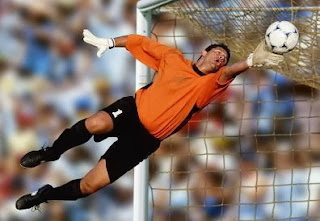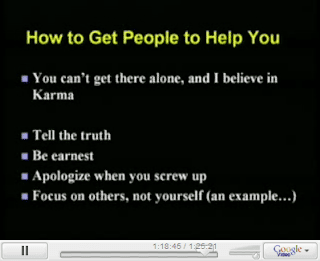Alex is a student in Ms. Toal’s class and wrote a blog about playing for Woodlawn football club. He started out as a striker, but he couldn’t score no matter how hard he tried. Then, he tried playing midfield, and wasn’t good at that either. The next year, he tried playing defense. He thought he had found his dream position and played defense for about half a year. Everyone was groaning about playing goalie, so he finally stood up and said, “I’ll do it”. His team had scored and was up 1-0. The other team tried to score, but Alex made an outstanding save. He got player of the game and till this day he still plays goalie.
Eric is a student in Mrs. Caddy's class and made an “About You” survey that consisted of ten questions. There were a variety of questions including favorite color, games, and cartoons. They had mentioned two questions about Mine craft, but I was not very familiar with it. He also asked what we liked and didn’t like. I am not sure if he was going to do anything with our answers or not. I have not seen anything else that is similar to this post.
Cynthia is a student in Ms. Ruiz’s 3rd period. She did her reflection on the book, Of Mice and Men. The title of the book should be “The Struggle”, because Lenny and George are having a hard time. When Lennie makes a mistake things become worse for them. Curley is the mean man and likes to pick on Lennie for not being smart or just for fun. George tells Lennie to stay away from Curley. Cynthia would not like to work with people like Curley because it would make her cry or lose her temper. She would get along with Lennie more than George though because he is nice and kind. George gives Lennie three rules to follow: stay away from Curley and his wife, speak when he is spoken to, and to go hide in a bush if he gets in trouble.
This student,thathippykid135, believes that the beach is not fun from personal experience. Some people enjoy the beach and some simply do not. One of their bad experiences occurred when they went with their older sister and her boyfriend. There were just too many people there and it was very loud. Their sister got a headache and had to sit in the car until it went away. They got sick and threw up from the salt water and got too much sun. They are scared of sharks, jellyfish, and other types of sea creatures.
Friday, February 28, 2014
Blog #7
Randy Pausch is known throughout the United States as a very inspirational speaker. He was a professor at Carnegie Mellon University. He has given many inspirational speeches throughout his life that are made to help you better your own life as well as pass the torch and make other people’s lives better.
In Randy Pausch's Last Lecture, the mood is a little bit different. We learn that Pausch has been diagnosed with pancreatic cancer; the doctors give him very little time to live. Even though he has been diagnosed with what will eventually lead to his death, he finds the strength to give his most powerful speech. Pausch will go into detail about his childhood, his dreams that become reality, his time as a college student, worker at Disney Imagineer, and professor.
We learn that during Randy’s childhood, he had several dreams which included going into space, playing in the NFL, meeting Captain Kirk off of Star Trek, becoming an Imagineer at Disney, and winning big stuffed animals at fairs. Throughout his life he eventually accomplishes all of these things except for playing in the NFL. Even though he did not play in the NFL, Pausch learns many valuable lessons while playing football as a nine year old boy. The first quote presented during his speech is: “Experience is what you get when you don’t get what you want”. This means that while Pausch did not make it to the NFL, he did learn about working hard during practice and finding out how bad you really want to achieve your goal. Another phrase that Pausch came up with is: “Brick walls are there to show how badly we want something”. Often times in life we are faced with challenges that may seem to overwhelm us when we are trying to achieve our goals. We learn that we have to learn how to push through this wall and overcome adversity to achieve our goals. We have to push ourselves if we want to be successful in this world. Nothing in this life comes without working hard for it. As teachers, we have to push our students to push themselves as hard as they can. Most students, in my opinion, don’t realize their full potential until they get out of their comfort zone and try to accomplish something once thought of as impossible. My goal as a teacher and coach is to push my students to be the best they can be. Another important concept Pausch introduces us to is called “head fake”. A head fake, in Pausch’s own words, simply states that the best way to teach someone something is to make them think they are learning something else. For example, take a group of kids to play a game of basketball. They think that they are out there to learn the game and learn the strategies behind it, but in retrospect, they are really learning communication skills and teamwork by speaking to each other on the court and passing the ball around trying to score. Also, by making learning fun helps keep your students engaged on the topic of communication and teamwork without them noticing.
In my opinion, the most important lessons that Pausch teaches us is toward the middle of the second half of his lecture. The first thing is that we cannot be successful in life on our own. We must help others out as much as we can along the way. He believes that karma is real in the fact that we get in return what we give. This means that if we help others out as much as we can, we in turn, will receive help from others when we most need it. He also states that we should not be afraid to ask for help. Second, we should always be honest in everything that we do. Not only should we take credit for the work that we do, we should also admit when we make mistakes. The best way to earn the respect of other people is to be honest. Personally, I like this concept the best. I appreciate when others are honest with me, therefore I must be honest with them to gain mutual respect. The last point Pausch makes is that we should focus on other people, not just ourselves. This is very important to me as a teacher because I will be engaging in young students lives every day at school. My students will look to me for guidance and leadership and it is my personal duty to help them out as best I can each and every day.
I really enjoyed listening to Pausch speak. He is very inspirational and opened my eyes to several key ideas that I can use daily while I teach and coach.
Sunday, February 23, 2014
Blog #6
In Steven Alexander’s blog, Building Your PLN- A Primer For Anyone, he talks about how many people are familiar with PLC’s. The school based groups meet to collaborate and work on learning for the kids. PLN, Personal Learning Network, is the same concept, but taking it to a global scale and expanding it outside of your school. Developing PLN’s help extend your thinking. You don’t have to know everything, but there is a network with thousands of educators to ask questions and converse with.
As a teacher I will encounter many questions throughout my life. Getting the answers will be through PLN’s. A PLN is a network that consists of people that interact together to exchange and receive information. I think PLN’s will be useful for when I am an educator. We don’t know everything so having a PLN will be helpful to get other information and to ask questions.
I have started my PLN’s, but it is not that big. I think having a Twitter, Blogger and doing C4K’s (Comment for Kids), would be very useful for my students. On Twitter, the students can get to know different things by what others tweet out. Also, they can learn from other professionals such as two teachers in EDM, Dr. Strange and Dr. Vitulli. Blogging is another tool I would use for my PLN. By blogging, it helps reach out to other students and teachers and get their feedback. I think the C4K’s are an awesome idea. The students will get to interact with each other on the internet and see what they are doing in their classes. Symbaloo is a great tool to have while organizing your PLN’s so that you can flip back and forth on the computer, but still have all your PLN’s up.

As a teacher I will encounter many questions throughout my life. Getting the answers will be through PLN’s. A PLN is a network that consists of people that interact together to exchange and receive information. I think PLN’s will be useful for when I am an educator. We don’t know everything so having a PLN will be helpful to get other information and to ask questions.
I have started my PLN’s, but it is not that big. I think having a Twitter, Blogger and doing C4K’s (Comment for Kids), would be very useful for my students. On Twitter, the students can get to know different things by what others tweet out. Also, they can learn from other professionals such as two teachers in EDM, Dr. Strange and Dr. Vitulli. Blogging is another tool I would use for my PLN. By blogging, it helps reach out to other students and teachers and get their feedback. I think the C4K’s are an awesome idea. The students will get to interact with each other on the internet and see what they are doing in their classes. Symbaloo is a great tool to have while organizing your PLN’s so that you can flip back and forth on the computer, but still have all your PLN’s up.

Sunday, February 16, 2014
Blog Assignment #5
In the video, Project Based Learning Part 1: Experiences of a 3rd Grade Teacher, Anthony Capps says projects are what you do at the end of a lesson to show what you learned. The goal now is not a means of what the students have achieved, but a means of getting them to learn something. The goal of a good project is to have an authentic audience, student interest, involve the community, and driven by content. Whenever he creates a project he thinks of something that will fit into the content standards. By covering the writing, reading, and social studies standards, he let his students send a letter to Jo Bonner. He also let the students use iCurio to research a female or minority historical figure that was successful when uncommon.

In this video,Project Based Learning Part 2: Experiences of a 3rd Grade Teacher, Dr. Strange interviews Anthony Capps. They discuss the teaching practice of Project Based Learning. Anthony Capps gave a great example of how he uses Project Based Learning in his third grade classroom. He had his students write a narrated script as if they were a child in Afghanistan. This gave the students the chance to explore their interests, state their point of view, and broaden their use of technology. I agree with Capps when he says that Project Based Learning is a way to really engage students. Their work is meaningful, and not just another worksheet to keep them busy. There was positive feedback from students, parents, and administrators. It wasn't just a learning process for the students, but also for Anthony Capps. I thought it was a great teaching strategy to use the feedback of students to help him develop the next project.

The third video, iCurio, an online tool which allows students to safely search websites for educational purposes. It allows the students to stop, and then pick right back up where they left off when they were researching information. Also, it can be used as storage for valuable content. The audio and video accessibility allows students with learning disabilities to prosper as well.
.png)
"If a picture is worth 1000 words, then a video is worth a million," Anthony Capps said about Discovery Education. Discovery Education is an online tool that uses audio, video, and pictures with textbook materials. Capps is very fond of Discovery Education, and believes that it helps students keep the information given to them in the videos. It is an amazing way for students to learn about social studies and science.
.jpg)
The video, The Anthony - Strange list of Tips for Teachers Part 1,Dr. Strange and Anthony Capps discusses what you can do as a teacher. This first thing is to be a learner. Dr. Strange stated that if you're not a good learner, then you cannot be a successful teacher. Being a teacher is hard work as well as exciting. The second thing to do is to be flexible; teachers will learn as they go meaning that their learning continues. They learn from their mistakes, and their successes to produce better instruction for the future. Finally, teachers need to figure out how to engage their students, and teach them to reflect on their own work. I feel like all of these goals are essential to be a great teacher. Teaching is not just reading off planned curriculum or handing out busy work; it is about how you can change the student’s life through learning while making them want to learn, and to be interested. Dr. Strange said there are more goals they need to cover in a later interview, and I looking forward to hearing those as well.
.jpg)
In the video, Don't Teach Tech - Use It Technology is still a controversial topic in today’s world. It should be part of your curriculum and shouldn’t be on your list of things to get. When designing projects, scaffold the technology you’re using. Technology is clean, sharable, and it’s real. The students will get used to using technology for later on in life when they are older. Let them use the technology for experience! They are not going to be perfect and are going to make mistakes. They are learning what they did wrong by reflection.

In the video, Additional Thought About Lessons, it says a lesson is at least four layers thick. How the lesson fits in with your year is the first layer. That means you are going to cover all of your content standards, and write a curriculum map to make sure that all contents are all covered. The second one is unit size. Devise unit projects to show that it meets the outcome that you are looking for. The third is that you want to be able to get everything done each week that you had planned. The last one is just as important as the other three; and that is how you are going to deliver the lesson each day. You want to keep them engaged while delivering the content. I think those are four important steps when creating lesson plans.


In this video,Project Based Learning Part 2: Experiences of a 3rd Grade Teacher, Dr. Strange interviews Anthony Capps. They discuss the teaching practice of Project Based Learning. Anthony Capps gave a great example of how he uses Project Based Learning in his third grade classroom. He had his students write a narrated script as if they were a child in Afghanistan. This gave the students the chance to explore their interests, state their point of view, and broaden their use of technology. I agree with Capps when he says that Project Based Learning is a way to really engage students. Their work is meaningful, and not just another worksheet to keep them busy. There was positive feedback from students, parents, and administrators. It wasn't just a learning process for the students, but also for Anthony Capps. I thought it was a great teaching strategy to use the feedback of students to help him develop the next project.

The third video, iCurio, an online tool which allows students to safely search websites for educational purposes. It allows the students to stop, and then pick right back up where they left off when they were researching information. Also, it can be used as storage for valuable content. The audio and video accessibility allows students with learning disabilities to prosper as well.
.png)
"If a picture is worth 1000 words, then a video is worth a million," Anthony Capps said about Discovery Education. Discovery Education is an online tool that uses audio, video, and pictures with textbook materials. Capps is very fond of Discovery Education, and believes that it helps students keep the information given to them in the videos. It is an amazing way for students to learn about social studies and science.
.jpg)
The video, The Anthony - Strange list of Tips for Teachers Part 1,Dr. Strange and Anthony Capps discusses what you can do as a teacher. This first thing is to be a learner. Dr. Strange stated that if you're not a good learner, then you cannot be a successful teacher. Being a teacher is hard work as well as exciting. The second thing to do is to be flexible; teachers will learn as they go meaning that their learning continues. They learn from their mistakes, and their successes to produce better instruction for the future. Finally, teachers need to figure out how to engage their students, and teach them to reflect on their own work. I feel like all of these goals are essential to be a great teacher. Teaching is not just reading off planned curriculum or handing out busy work; it is about how you can change the student’s life through learning while making them want to learn, and to be interested. Dr. Strange said there are more goals they need to cover in a later interview, and I looking forward to hearing those as well.
.jpg)
In the video, Don't Teach Tech - Use It Technology is still a controversial topic in today’s world. It should be part of your curriculum and shouldn’t be on your list of things to get. When designing projects, scaffold the technology you’re using. Technology is clean, sharable, and it’s real. The students will get used to using technology for later on in life when they are older. Let them use the technology for experience! They are not going to be perfect and are going to make mistakes. They are learning what they did wrong by reflection.

In the video, Additional Thought About Lessons, it says a lesson is at least four layers thick. How the lesson fits in with your year is the first layer. That means you are going to cover all of your content standards, and write a curriculum map to make sure that all contents are all covered. The second one is unit size. Devise unit projects to show that it meets the outcome that you are looking for. The third is that you want to be able to get everything done each week that you had planned. The last one is just as important as the other three; and that is how you are going to deliver the lesson each day. You want to keep them engaged while delivering the content. I think those are four important steps when creating lesson plans.

Sunday, February 9, 2014
Blog Assignment #4
After reading, "The Right Way to Ask Questions in the Classroom" by Ben Johnson, I realized that when teachers ask questions they aren't giving the students a chance to learn all the information. When teachers ask their students if they have any questions, it will benefit them more than the students. Many students will not raise their hand to ask questions when they really do because either they get embarrassed easily or they do not want to get made fun of. Because of this the teacher often moves onto the next lesson leaving students behind in the curriculum. A good way to make sure that the students understand the material is by calling on them. This allows the students who don't ask questions an opportunity to show that they understand the material.
The blog, "Asking Questions to Improve Learning", gives many different recommendations about asking questions, and also provides different ways to respond effectively. The article states not to ask lead questions so that the students will think on their own. Teachers should ask questions that are direct, clear, and specific. Making sure that students know the answers to these types of questions will help them with more in-depth questions. One strategy that really caught my attention is following an additional question to the "yes or no" questions. This makes the students explain their answers and show that they know and understand the material.
In the blog, "Three Ways to Ask Better Questions in the Classroom", tells us too prepare questions, play with questions, and preserve good questions. Preparing questions will really benefit the students. The teacher will come to class ready with content, but when asking questions off of the top of their head, the students will not know the answer. Thinking the questions through more thoroughly will help make the question clearer. Playing with the questions gives the students a chance to think about the question and come up with several different answers. Preserving good questions shows the importance of questions. It shows how they make us think and learn. Through this, the students will start asking better questions.

The blog, "Asking Questions to Improve Learning", gives many different recommendations about asking questions, and also provides different ways to respond effectively. The article states not to ask lead questions so that the students will think on their own. Teachers should ask questions that are direct, clear, and specific. Making sure that students know the answers to these types of questions will help them with more in-depth questions. One strategy that really caught my attention is following an additional question to the "yes or no" questions. This makes the students explain their answers and show that they know and understand the material.
In the blog, "Three Ways to Ask Better Questions in the Classroom", tells us too prepare questions, play with questions, and preserve good questions. Preparing questions will really benefit the students. The teacher will come to class ready with content, but when asking questions off of the top of their head, the students will not know the answer. Thinking the questions through more thoroughly will help make the question clearer. Playing with the questions gives the students a chance to think about the question and come up with several different answers. Preserving good questions shows the importance of questions. It shows how they make us think and learn. Through this, the students will start asking better questions.

C4T #1
Reflections and crystal balling is a blog written by Brendan Jones, a Physical Education teacher. Jones has just finished his 7th year of teaching. The blog begins with him explaining how he struggled after going back to school after being away at an office. He explains that he felt like an inexperienced teacher in front of all the classes he taught. However, by the end of the year he was able to feel more comfortable. In the blog, you see that he taught using ideas that were inspired by other educators. Jones also described how he would watch PEPLC and PEPRN to grow and stimulate global thinking and collaboration. Throughout the blog, Jones states about how he used videos, twitter, and ect to help him with his teaching. At the end of the blog, Jones talks about how his school will be using BYOD/ eTech and Google Apps for Education. Also, he is very enthusiastic about the new software and he will be trying to get the staff to like it as well. He ends the blog saying that he is passionate about engaging kids in Physical Education and he will be making their learning his core purpose.
Hi Jonsey, I was very intrigued by your post. I really did not know how much there was to being a Physical Education teacher. I admire how you praise other passionate operators like Bianca Hewes and her husband. I can see that you have a great deal of passion towards your work. I love that you care about wanting the kids to learn about Physical Education. I hope you have a great year of teaching!

Brendan Jones was wondering what types of things Physical Education teachers did in a blog called marking and feedback in P.E. He created a survey worldwide for the teachers. He collected the data that he received and turned it into a visual presentation using Spicynodes. By clicking on each node, it will give you a type effect. Only 14 people responded to his surgery. Though it was not a lot, it got responses to the questions he asked. There was not a lot of data about the task, homework, or tests from practical or theory classes. Marking and feedback mainly came from theory classes. He then posted an image that was a link to his Spicynode visualization.
I thought the Spicynode visualization was really cool. I found that it is a great way to get feedback from other teachers. There were many examples of feedback, I particularly liked the one about explaining to students how to improve their answers.

Hi Jonsey, I was very intrigued by your post. I really did not know how much there was to being a Physical Education teacher. I admire how you praise other passionate operators like Bianca Hewes and her husband. I can see that you have a great deal of passion towards your work. I love that you care about wanting the kids to learn about Physical Education. I hope you have a great year of teaching!

Brendan Jones was wondering what types of things Physical Education teachers did in a blog called marking and feedback in P.E. He created a survey worldwide for the teachers. He collected the data that he received and turned it into a visual presentation using Spicynodes. By clicking on each node, it will give you a type effect. Only 14 people responded to his surgery. Though it was not a lot, it got responses to the questions he asked. There was not a lot of data about the task, homework, or tests from practical or theory classes. Marking and feedback mainly came from theory classes. He then posted an image that was a link to his Spicynode visualization.
I thought the Spicynode visualization was really cool. I found that it is a great way to get feedback from other teachers. There were many examples of feedback, I particularly liked the one about explaining to students how to improve their answers.

Subscribe to:
Comments (Atom)


.jpg)
